As you start planning your succulent rock garden, you're likely envisioning a striking display of unique shapes and vibrant colors. But before you can bring your vision to life, you need to lay the groundwork – literally. You'll need to choose the right succulents, select rocks and gravel that complement their beauty, and prepare the site for your new garden. With a solid foundation in place, you can start thinking about the layout structure and visual interest points that will take your garden from ordinary to extraordinary. But what's the best way to get started, and what essential elements should you prioritize?
Choosing the Right Succulents

When designing a succulent rock garden, you'll want to select a diverse range of species that thrive in dry conditions and can tolerate intense sunlight, as this will guarantee a visually striking and resilient arrangement.
Succulent varieties like Echeveria, Crassula, and Sedum are ideal choices, as they come in a range of shapes, sizes, and colors, and can be combined to create a unique and enchanting display.
Consider succulent hardiness when making your selection, as some species are more sensitive to temperature fluctuations and humidity than others.
Look for varieties with hardiness ratings that match your local climate, ensuring your plants will thrive in their new environment.
For example, if you live in a region with hot summers and mild winters, you may opt for succulents like Aloe or Agave, which can tolerate high temperatures and drought.
Selecting Rocks and Gravel

When building your succulent rock garden, you'll need to select rocks and gravel that complement your plants' unique shapes and colors.
You'll want to ponder the textures and types of rocks, as well as the colors and sizes of gravel, to create a visually appealing contrast.
Rock Types and Textures
You'll need a mix of rock types and textures to create a visually appealing succulent rock garden, with varying sizes, shapes, and colors that complement your plants.
When selecting rocks, consider the unique characteristics of different rock formations. For instance, sedimentary rocks like limestone and sandstone offer a soft, earthy tone, while igneous rocks like granite and basalt provide a bold, rugged look.
You can also incorporate metamorphic rocks like marble and slate for added visual interest.
In addition to rock formations, explore pebble varieties to add depth and complexity to your design.
River rocks, with their smooth, rounded edges, create a soothing atmosphere, while decomposed granite (DG) adds a rustic, natural feel.
You can also use polished pebbles to create a striking contrast against the rough, fleshy texture of your succulents.
Gravel Color and Size
Selecting gravel in a range of colors and sizes is essential to creating a visually appealing succulent rock garden, as it allows you to balance contrast and harmony among your plants and hardscape.
When choosing gravel, consider the gravel aesthetics – the color palette should complement your succulents' hues and the overall garden theme. Neutral shades like beige, gray, or brown provide a subtle background, while bold colors like red, orange, or yellow can add vibrancy.
Gravel size is also pivotal, as it affects gravel functionality. Larger gravels (1-2 inches) create a dramatic, rustic look and allow for better drainage, while smaller gravels (1/4-1/2 inch) provide a more uniform, refined appearance and can help retain moisture.
A mix of gravel sizes can create a dynamic, layered effect. Consider the scale of your plants and hardscape features when selecting gravel size.
Preparing the Garden Site

Clear the chosen site of any debris, weeds, or obstructions to create a clean slate for your succulent rock garden.
This site clearing process is vital to guarantee a smooth and even surface for your design. Remove any rocks, twigs, or leaves that may be scattered around the area. If you encounter any stubborn weeds, use a shovel or a weeding tool to carefully remove them, making sure to get as much of the root system as possible.
Once the site is clear, take a moment to inspect the ground for any low-lying areas or unevenness. Use a rake or a trowel to level out the ground, creating a smooth and even surface.
Next, take out your garden mapping tools, such as a measuring tape, string, and stakes. Measure out the dimensions of your garden bed, marking the boundaries with the string and stakes.
Take note of any existing features, such as nearby plants or hardscapes, that may impact your design. With your site cleared and mapped, you'll be ready to start designing your succulent rock garden, incorporating the unique features of your chosen site into your innovative design.
Designing the Layout Structure

As you start designing the layout structure of your succulent rock garden, you'll need to visualize the overall aesthetic you want to achieve.
You'll want to ponder the rock formation patterns, thinking about how you can create a natural-looking arrangement that complements your succulents.
Rock Formation Patterns
You'll create visual interest in your succulent rock garden by arranging rocks into patterns that evoke natural formations, such as meandering rivers or rolling hills.
To achieve this, consider incorporating rock cairns, which are stacks of rocks that add a sense of drama and verticality to your design. Place them strategically to create focal clusters, drawing the viewer's eye to specific areas of the garden.
Another approach is to create a serpentine pattern, where rocks are arranged in a winding, organic shape that mimics the flow of a river.
This can be especially effective when paired with succulents that have a trailing or creeping habit, such as Sedum or Echeveria.
Alternatively, you can create a more geometric pattern, using rocks of similar size and shape to create a grid or mosaic effect.
The key is to experiment and find a pattern that resonates with your personal style and complements the overall aesthetic of your succulent rock garden.
Garden Bed Design
With your rock formation patterns in place, now it's time to structure the layout of your garden bed, carefully allocating space for each succulent species and incorporating hardscaping elements that enhance the overall design.
You'll want to create a visually appealing layout that balances form and function. Consider incorporating garden curves to add movement and flow to your design. These gentle, sweeping curves can help to create a sense of harmony and balance in your rock garden.
When designing your garden bed, think about the border shapes you want to use. Will you opt for clean, geometric lines or softer, more organic shapes? Perhaps a combination of both will create the visual interest you're looking for.
Consider using a mix of succulent species with varying textures, colors, and growth habits to add depth and dimension to your design. Don't forget to leave space for pathways and walkways, allowing visitors to meander through your rock garden and take in the beauty of your succulent creations.
Creating Visual Interest Points
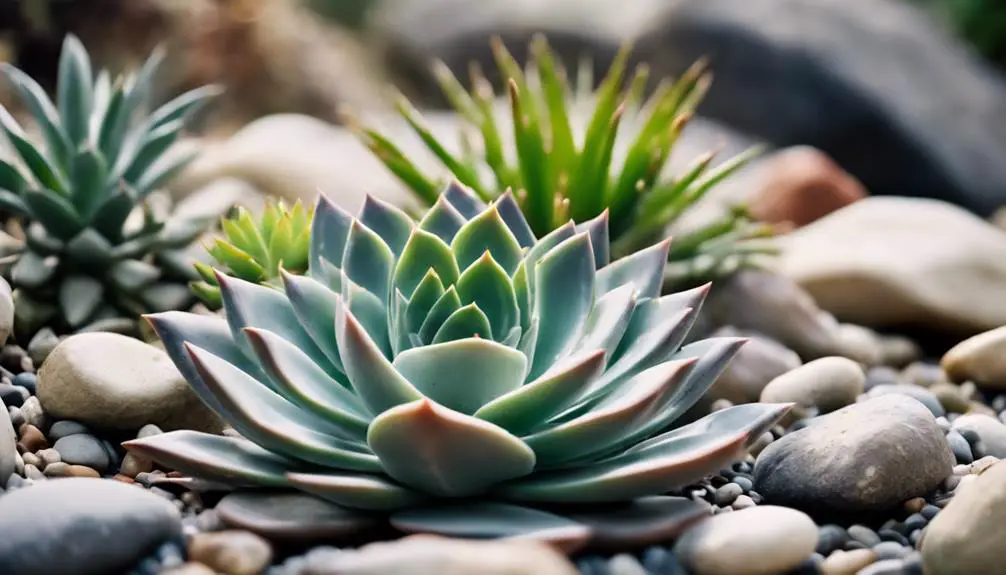
Creating Visual Interest Points
Carefully positioning a few statement succulents throughout your rock garden creates focal points that draw the eye and add depth to the overall design.
These visual anchors capture attention, guiding the viewer's gaze through the garden.
You can strategically place them to create a sense of movement, leading the eye to explore different areas of the garden.
To create visual interest, consider the size, shape, and color of your succulents.
Larger, more vibrant plants can serve as focal points, while smaller, more subtle ones can add texture and depth.
You can also use succulents with unique shapes or forms to add visual intrigue.
By thoughtfully arranging your succulents, you can create a visually appealing rock garden that invites exploration.
Adding Decorative Elements
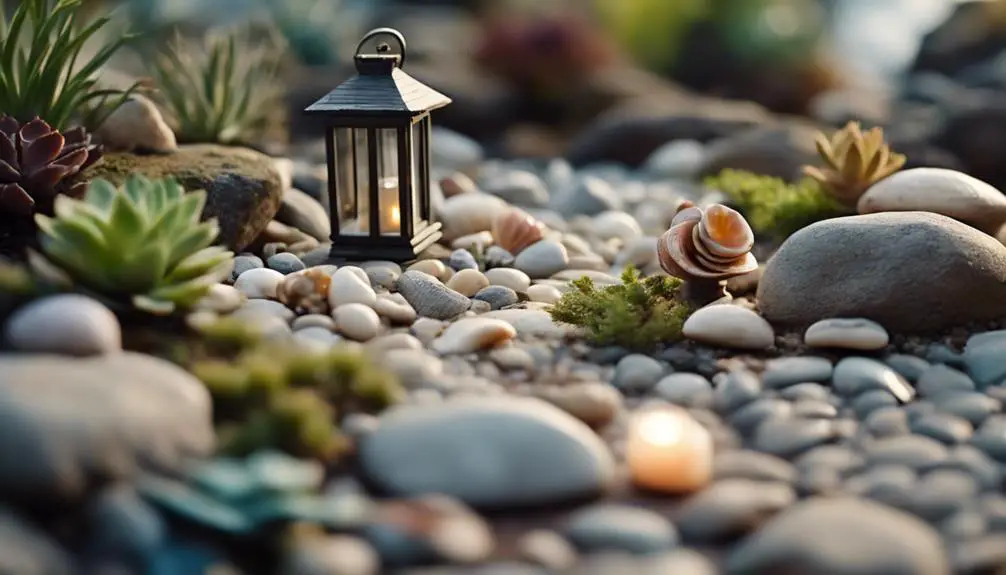
Beyond the visual anchors created by your strategically placed succulents, incorporating decorative elements such as rocks, pebbles, or driftwood can further enrich the aesthetic of your rock garden.
These decorative accents can add texture, color, and depth to your layout, creating a visually appealing contrast to the smooth, fleshy succulents. Consider adding garden ornaments like miniature sculptures, bird baths, or wind chimes to create a unique focal point.
You can also use decorative stones or pebbles to create a mosaic pattern or a meandering pathway, drawing the viewer's eye through the garden.
When selecting decorative elements, think about the overall style and theme of your rock garden.
For a modern look, opt for sleek, minimalist ornaments, while a more rustic or whimsical design might call for natural, weathered elements like driftwood or moss-covered stones.
Remember to balance your decorative elements with the succulents, ensuring they complement rather than overpower each other.
Soil and Drainage Considerations
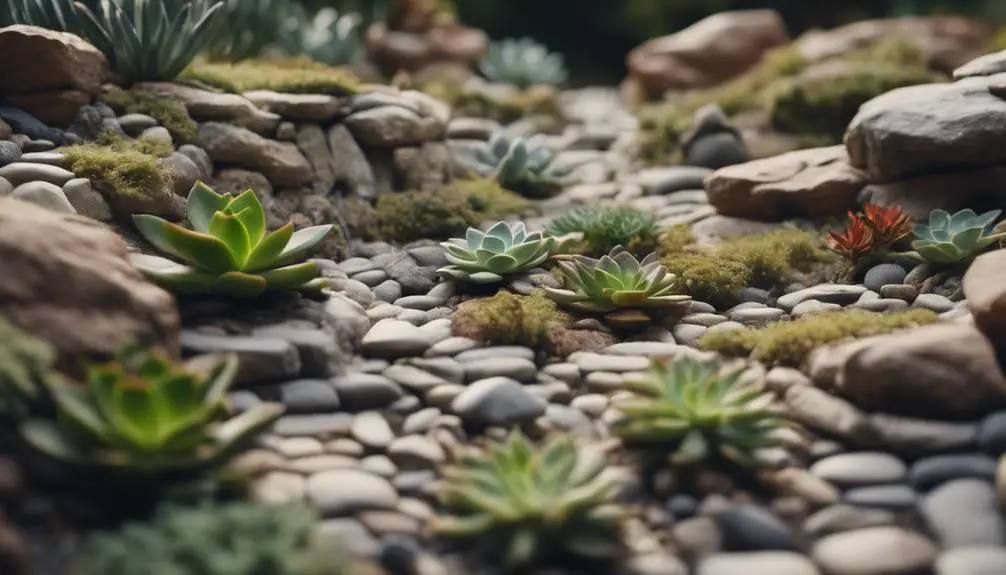
As you design your succulent rock garden, you'll need to ponder the soil's composition – is it well-draining, or will it retain too much water?
You'll want to create a mix that allows excess water to flow through, preventing waterlogged soil that can rot your plants' roots.
Soil Composition Matters
You'll want to carefully select a soil mix that mimics the dry, well-draining conditions found in succulents' natural habitats, where rocky outcrops and sandy plains dominate the landscape.
To achieve this, you'll need to examine the soil composition and make adjustments accordingly. Soil testing methods, such as pH analysis and texture evaluation, will help you identify areas for improvement.
Based on your test results, you may need to incorporate organic amendments like perlite, vermiculite, or sand to enhance drainage and aeration.
Aim for a mix that's roughly 50% inorganic matter, such as rocks, gravel, or sand, and 50% organic matter, like peat moss or compost.
This will create a well-balanced soil structure that allows for efficient water penetration and prevents waterlogging. Be cautious of over-amending, as this can lead to water retention and root rot.
By tailoring your soil composition to your succulents' needs, you'll create an environment that fosters healthy growth and thriving plants.
Proper Water Flow
Set your succulents up for success by designing a soil structure that allows water to flow freely, preventing stagnation and ensuring roots receive the right amount of moisture. You want to create a system where water can absorb quickly, without pooling or collecting in the soil. This is vital for succulents, as they're prone to root rot in waterlogged conditions.
To achieve ideal water flow, incorporate a mix of porous materials like perlite, vermiculite, or sand into your soil composition. These materials will improve water absorption, allowing excess water to drain quickly and efficiently. Visualize the water flowing through the soil like a network of underground streams, nourishing the roots without causing damage.
Create drainage channels by layering small rocks or gravel at the bottom of your planters or garden beds. This will help direct excess water away from the roots, preventing waterlogging and ensuring healthy growth. By designing a soil structure that prioritizes water flow, you'll give your succulents the best chance to thrive in their rock garden home.
Watering and Irrigation Tips
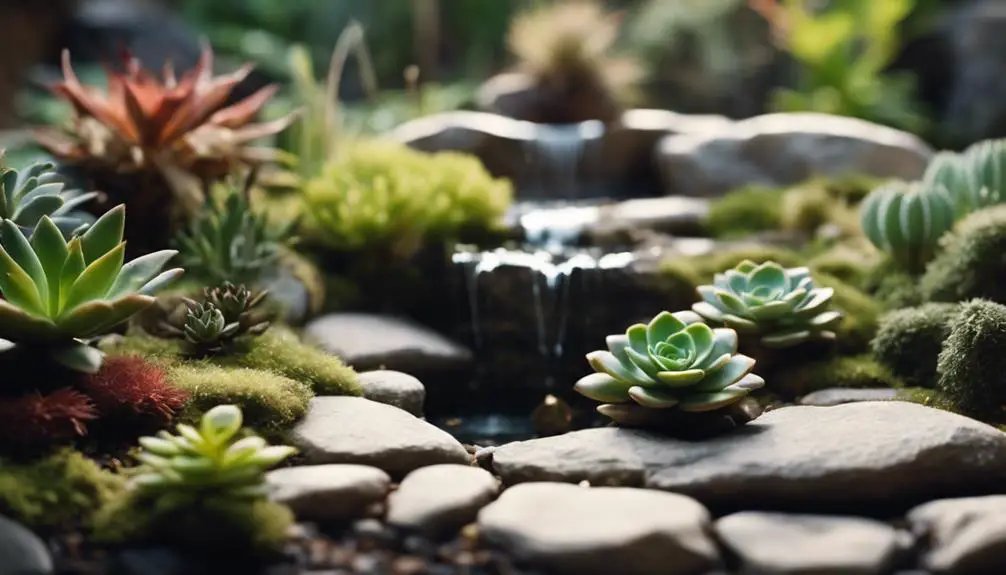
Watering your succulent rock garden requires precision, since these plants thrive in dry conditions and are prone to rot if overwatered.
To avoid this, you'll want to implement a targeted watering system. Drip irrigation is an excellent option, as it delivers water directly to the roots, reducing evaporation and runoff. This method also encourages deep root growth, making your succulents more resilient.
To take it a step further, incorporate moisture monitoring into your routine. Invest in a soil moisture meter or a smart watering system that tracks moisture levels.
This will give you a clear picture of when your plants need water, and when they can wait. By monitoring moisture levels, you'll avoid overwatering and guarantee your succulents receive the perfect amount of hydration.
Visualize your plants thriving in their rocky habitat, their leaves plump and vibrant, thanks to your precise watering strategy.
With these tips, you'll be well on your way to creating a stunning, low-maintenance succulent rock garden that will impress even the most discerning gardeners.
Incorporating Vertical Elements
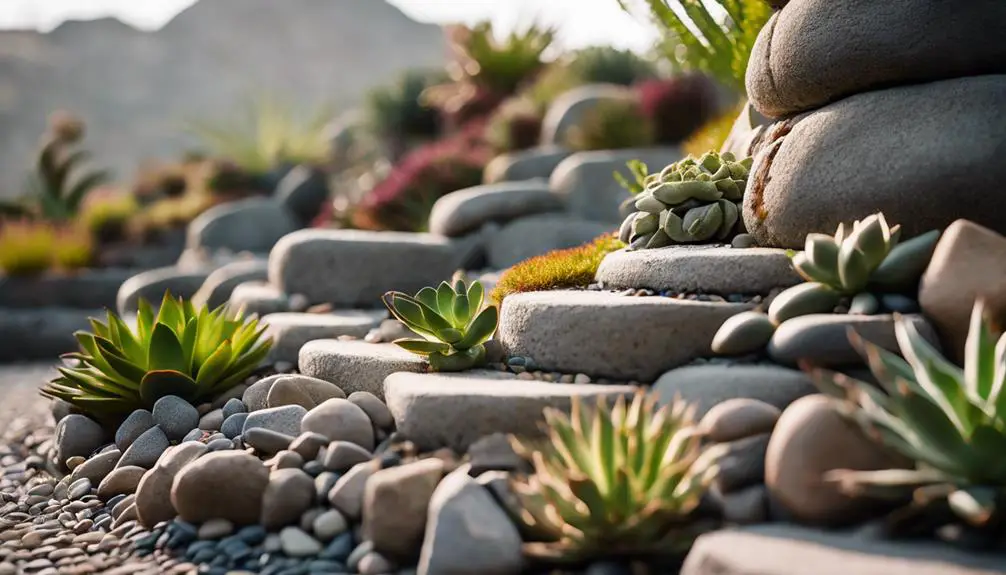
As you've crafted a precise watering strategy, now it's time to add visual interest to your succulent rock garden by incorporating vertical elements that will draw the eye upward and create a sense of depth.
One way to do this is by using wall planters, which can be attached to a fence, wall, or trellis. These planters add a touch of modernity to your garden while showcasing your favorite succulent species.
Consider pairing them with a living screen, a lush, verdant wall of plants that will provide a striking backdrop for your rock garden. Living screens can be trained to grow up a trellis or a wall, creating a sense of seclusion and intimacy.
Mixing Succulent Shapes
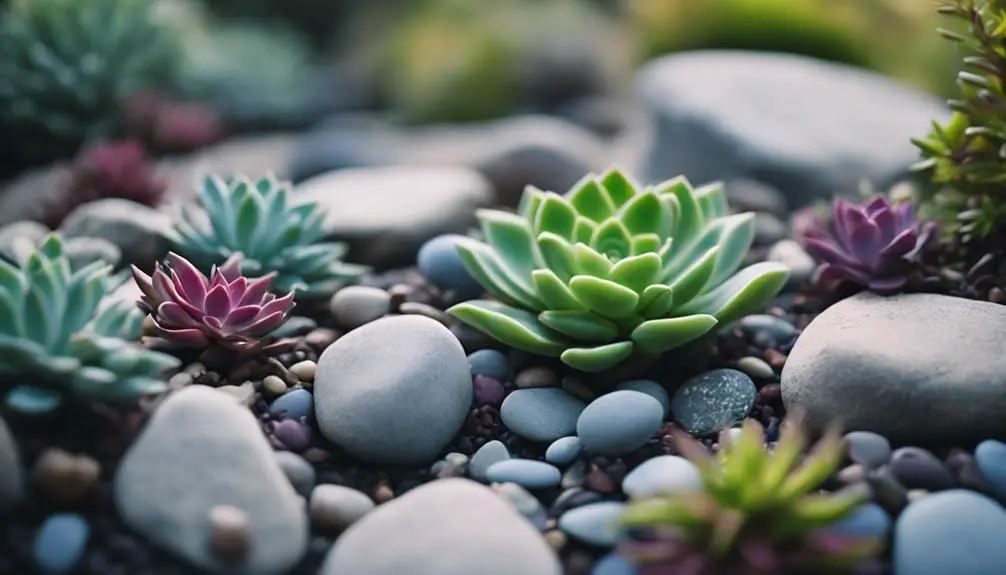
By combining succulents with diverse shapes, such as globular Echeveria, sprawling Sedum, and cylindrical Cylindropuntia, you can craft a visually dynamic arrangement that plays on contrasting forms and textures.
This succulent pairing approach allows you to create a harmonious balance of shapes, adding depth and visual interest to your rock garden.
To achieve shape harmony, consider the overall silhouette of each succulent and how they'll interact with one another. For instance, pair rounded succulents like Echeveria with more angular ones like Cylindropuntia to create a striking contrast.
You can also use sprawling succulents like Sedum to fill gaps and create a sense of movement. Don't be afraid to experiment with different combinations – the key is to find a balance that pleases your eye.
Balancing Color and Texture
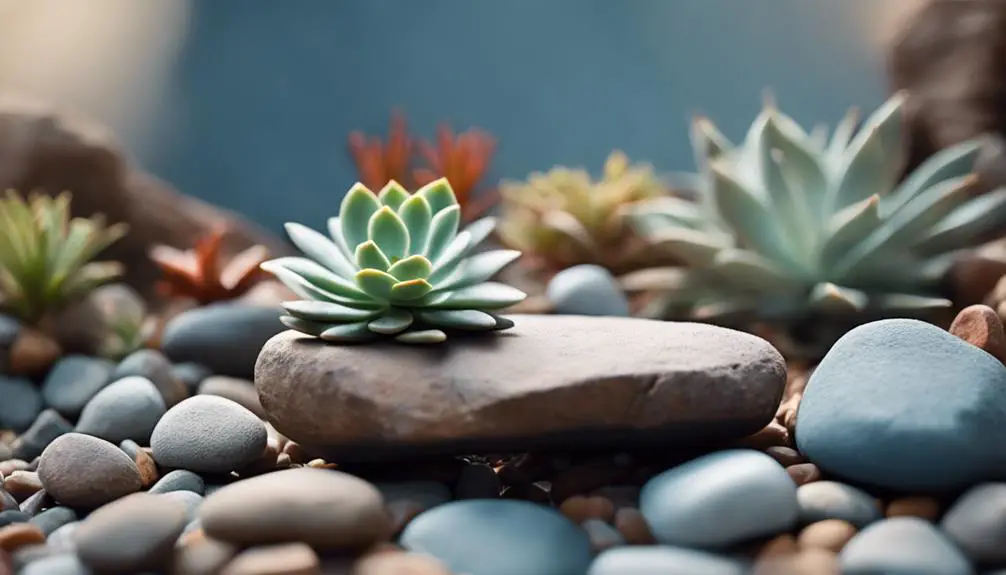
When designing your succulent rock garden, you'll want to carefully balance color and texture to create a visually appealing arrangement that engages the viewer's eye.
This harmony is vital, as it directs the viewer's attention and creates a sense of cohesion.
To achieve color harmony, select succulents with similar hues, such as blues and greens, or contrasting colors that complement each other, like oranges and purples.
You can also use rocks and gravel in varying shades to add depth and visual interest.
Texture contrast is equally important, as it adds dimensionality to your arrangement.
Combine smooth, rounded succulents like echeverias with rough, spiky ones like cacti.
You can also incorporate different rock textures, such as rough granite or smooth river rocks, to create a visually appealing contrast.
By balancing color and texture, you'll create a succulent rock garden that's both beautiful and engaging.
Adding Pathways and Borders
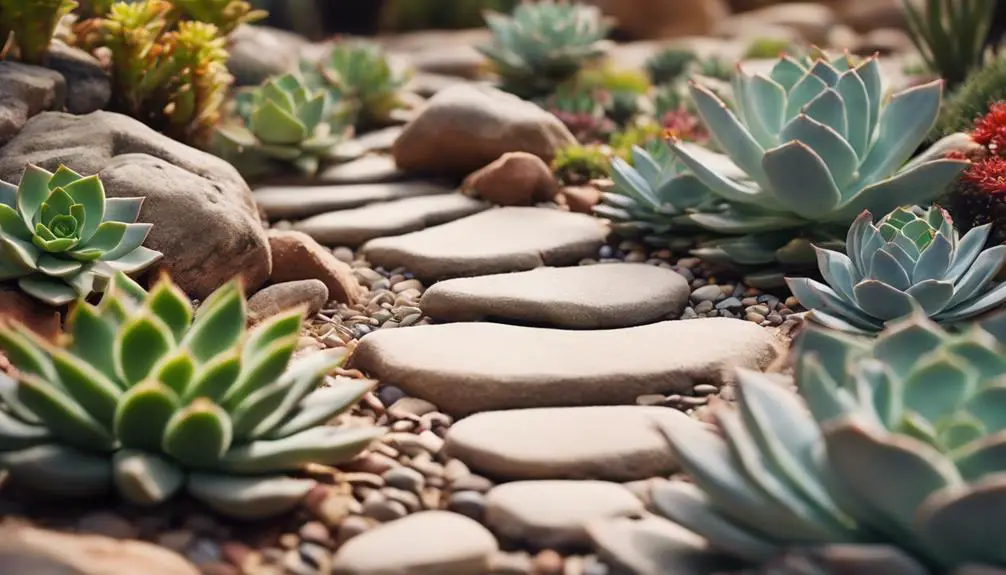
You can define the boundaries of your succulent rock garden and create a sense of flow by incorporating pathways and borders that complement the arrangement's color and texture.
When selecting pathway materials, consider the overall aesthetic you want to achieve. Gravel or decomposed granite pathways can add a rustic touch, while concrete or stone pavers can create a more modern look. You can also use wood chips or mulch for a natural, earthy feel.
For borders, you can choose from a variety of styles to enhance the visual appeal of your garden. A simple stone border can create a clean, minimalist look, while a decorative metal edging can add a touch of elegance. You can also use succulents themselves as a border, creating a beautiful, lush edge around your garden.
Consider using a mix of border styles to add visual interest and create a unique, eye-catching design. By thoughtfully selecting pathway materials and border styles, you can create a cohesive, visually stunning succulent rock garden that showcases your creativity and attention to detail.
Maintenance and Upkeep Essentials
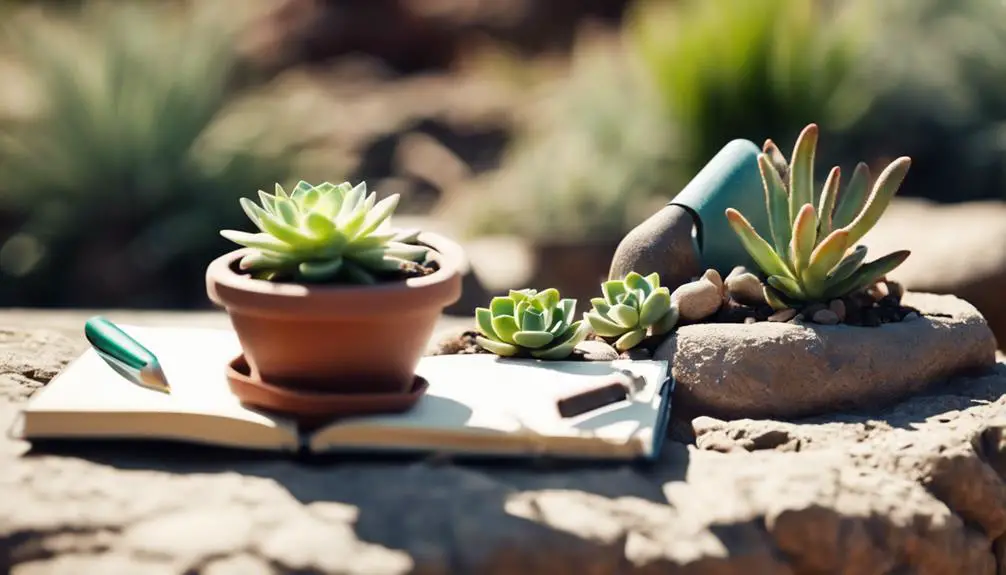
As your succulent rock garden takes shape, regular maintenance becomes vital to preserve its beauty and guarantee the health of your plants.
To safeguard your garden remains vibrant, establish a weekly schedule to monitor and address its needs. Water your succulents sparingly, as overwatering is a common pitfall. Inspect your plants for signs of pests, diseases, or nutrient deficiencies, and take prompt action if you notice any issues. Remove weeds and debris, and prune plants to maintain their shape and promote healthy growth.
As the seasons change, make seasonal adjustments to your maintenance routine. During the active growing season, increase watering and fertilization to support your succulents' development. In the dormant season, reduce watering and protect your plants from extreme temperatures and frost.
Mulch around the base of your plants to retain moisture and regulate soil temperature. By staying on top of maintenance, you'll be rewarded with a thriving, visually stunning succulent rock garden that continues to evolve and impress.
Frequently Asked Questions
Can I Use Succulents in a Shaded Rock Garden?
You can use succulents in shaded areas, but you'll need to choose varieties with high shade tolerance, like low-growing, delicate species; select succulents that thrive in indirect light, and be mindful of their specific shade requirements for ideal growth.
How Often Should I Fertilize My Succulent Rock Garden?
You'll want to fertilize your succulents sparingly, as overfeeding can be detrimental. Feed them during the growing season (spring-fall) with a balanced, water-soluble fertilizer, applying it once a month to provide essential succulent nutrients at ideal fertilizer timing.
Will Succulents Attract Pests to My Rock Garden?
You'll want to know that succulents can attract pests, but you can deter them with pest control methods like neem oil and natural deterrents such as crushed eggshells or sharp gravel around your plants.
Can I Create a Succulent Rock Garden in a Container?
You can create a thriving container garden by selecting a container with sufficient size to accommodate your succulents' mature size, and ensuring it has adequate drainage holes to prevent waterlogged soil.
Are There Any Pet-Friendly Succulent Rock Garden Options?
When creating a pet-friendly garden, you'll want to avoid toxic plants like Oleander, Sago Palm, and Castor Bean, which can harm your furry friends. As a pet owner, you'll appreciate non-toxic alternatives like Peppy Pincushion and Woolly Thyme.
Conclusion
As you step back to admire your succulent rock garden, notice how the carefully chosen species thrive in the dry conditions and intense sunlight.
The strategically placed rocks and gravel create a striking contrast, drawing the eye to the statement succulents.
Your meticulous planning and design have paid off, yielding a visually stunning oasis that's both beautiful and resilient.




